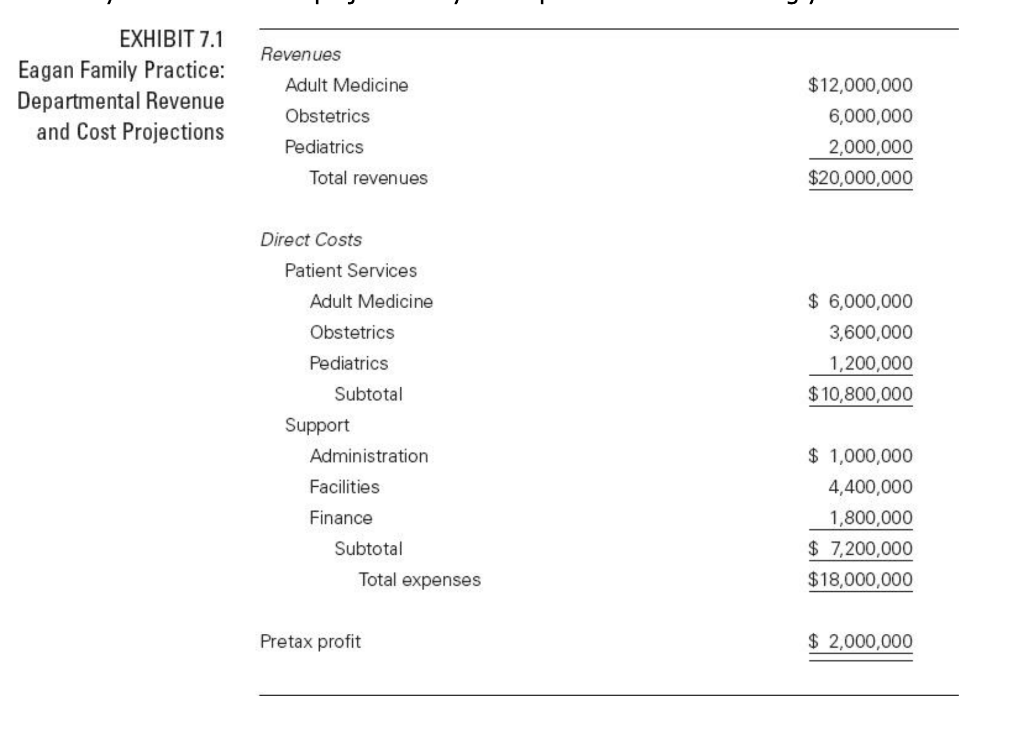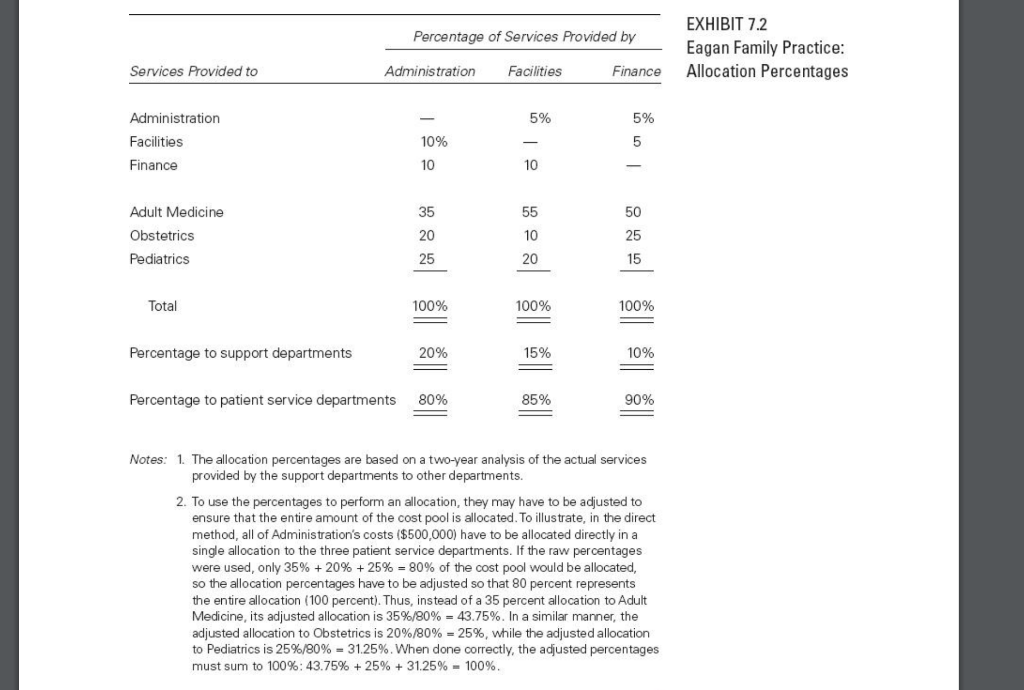What are the allocations to each patient services department, and resulting 6 profitability, under the four allocation methods using the base case cost amounts (exhibit 7.1) and allocation rates (Exhibit 7.2).

EXHIBIT 7.1 Eagan Family Practice: Departmental Revenue and Cost Projections Revenues Adult Medicine Obstetrics $12,000,000 6,000,000 2,000,000 $20,000,000 Pediatrics Total revenues $ 6,000,000 3,600,000 1,200,000 $10,800,000 Direct Costs Patient Services Adult Medicine Obstetrics Pediatrics Subtotal Support Administration Facilities Finance Subtotal Total expenses $ 1,000,000 4,400,000 1,800,000 $ 7,200,000 $18,000,000 Pretax profit $ 2,000,000 Percentage of Services Provided by EXHIBIT 7.2 Eagan Family Practice: Allocation Percentages Services Provided to Administration Facilities Finance 5% 5 Administration Facilities 10% 5 Finance 10 10 35 55 50 Adult Medicine Obstetrics Pediatrics 20 10 25 25 20 15 %s - a 86| || || || Total 100% 100% 100% Percentage to support departments 20% 15% Percentage to patient service departments 80% 85% Notes: 1. The allocation percentages are based on a two-year analysis of the actual services provided by the support departments to other departments. 2. To use the percentages to perform an allocation, they may have to be adjusted to ensure that the entire amount of the cost pool is allocated. To illustrate, in the direct method, all of Administration's costs ($500,000) have to be allocated directly in a single allocation to the three patient service departments. If the raw percentages were used, only 35% + 20% + 25% = 80% of the cost pool would be allocated, so the allocation percentages have to be adjusted so that 80 percent represents the entire allocation (100 percent). Thus, instead of a 35 percent allocation to Adult Medicine, its adjusted allocation is 35%/80% = 43.75%. In a similar manner, the adjusted allocation to Obstetrics is 20%/80% = 25%, while the adjusted allocation to Pediatrics is 25%/80% - 31.25%. When done correctly, the adjusted percentages must sum to 100%: 43.75% + 25% + 31.25% - 100% EXHIBIT 7.1 Eagan Family Practice: Departmental Revenue and Cost Projections Revenues Adult Medicine Obstetrics $12,000,000 6,000,000 2,000,000 $20,000,000 Pediatrics Total revenues $ 6,000,000 3,600,000 1,200,000 $10,800,000 Direct Costs Patient Services Adult Medicine Obstetrics Pediatrics Subtotal Support Administration Facilities Finance Subtotal Total expenses $ 1,000,000 4,400,000 1,800,000 $ 7,200,000 $18,000,000 Pretax profit $ 2,000,000 Percentage of Services Provided by EXHIBIT 7.2 Eagan Family Practice: Allocation Percentages Services Provided to Administration Facilities Finance 5% 5 Administration Facilities 10% 5 Finance 10 10 35 55 50 Adult Medicine Obstetrics Pediatrics 20 10 25 25 20 15 %s - a 86| || || || Total 100% 100% 100% Percentage to support departments 20% 15% Percentage to patient service departments 80% 85% Notes: 1. The allocation percentages are based on a two-year analysis of the actual services provided by the support departments to other departments. 2. To use the percentages to perform an allocation, they may have to be adjusted to ensure that the entire amount of the cost pool is allocated. To illustrate, in the direct method, all of Administration's costs ($500,000) have to be allocated directly in a single allocation to the three patient service departments. If the raw percentages were used, only 35% + 20% + 25% = 80% of the cost pool would be allocated, so the allocation percentages have to be adjusted so that 80 percent represents the entire allocation (100 percent). Thus, instead of a 35 percent allocation to Adult Medicine, its adjusted allocation is 35%/80% = 43.75%. In a similar manner, the adjusted allocation to Obstetrics is 20%/80% = 25%, while the adjusted allocation to Pediatrics is 25%/80% - 31.25%. When done correctly, the adjusted percentages must sum to 100%: 43.75% + 25% + 31.25% - 100%








